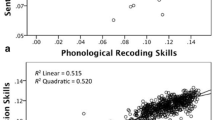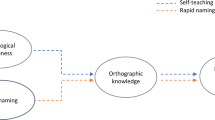Abstract
This study explores the ability to access word boundaries of pre-school children, using an on-line methodology (Karmiloff-Smith, Grant, Sims, Jones, & Cockle (1996). Cognition, 58, 197–219.), which has hardly been used outside English-speaking countries. In a cross-linguistic study in the Netherlands and Norway, four and five-year-old children were asked to repeat the last word every time a narrator stopped reading a story. In total 32 target-words were used, both closed and open class words, and both monosyllabic and disyllabic words. The outcomes in both countries were different from those of the original English study (Karmiloff-Smith et al., 1996): four- and five-year-olds were successful in only about 26% of the cases, whereas the success rate in the former English experiment was 75% for the younger and 96% for the older children. No differences were found between age groups and between open and closed class words. This methodology does reveal the ability to access word boundaries, but probably not because of the ease of the on-line methodology in itself, but rather because literacy introduces new representations of language, even in on-line processing. The outcomes implicate that the ability to mark word boundaries does not seem to be a valid indication of who is ready for reading.
Similar content being viewed by others
References
Adams M.J. (1990). Beginning to read. Thinking and learning about print. MIT Press, Cambridge, MA
Backus A. (2003). Units in codeswitching: evidence for multimorphemic elements in the lexicon. Linguistics 41(1): 83–132
Berthoud-Papandropoulou I. (1978). An experimental study of children’s ideas about language. In Sinclair A., Jarvella R., Levelt W. (eds). The child’s conception of language. Springer Verlag, Berlin, pp. 55–64
Bialystok E. (1986). Children’s concept of word. Journal of Psycholinguistic Research 15(1): 13–32
Bialystok E., Ryan E. (1985). Ametacognitive framework for the development of first and second language sklills. In Forest-Pressley D., MacKnnon G., Waller T. (eds). Metacognition, cognition and human performance. Academic Press, New York
Bialystok E. (1988). Levels of bilingualism and levels of linguistic awareness. Developmental Psychology 24, 560–567
Blachman B. (2000). Phonological awareness. In Kamil L., et al. (eds). Handbook of reading research. vol. III. Lawrence Erlbaum Ass, Mahwah, NJ/London, pp. 483–502
Blanche-Benveniste C. (1997). The unit in written and oral language. In Pontecorvo C. (eds). Writing development. An interdisciplinary view. John Benjamins, Amsterdam, pp. 21–45
Bowey J., Tunmer W., Pratt Ch. (1983). Development of children’s understanding of the metalinguistic term word. Journal of Educational Psychology 76(3): 500–512
Bowey J., Tunmer W. (1984). Word awareness in childeren. In Tunmer W., Pratt C., Herriman J. (eds). Metalinguistic awareness in children. Springer Verlag, Berlin, pp. 73–91
Bradley L., Bryant P. (1983). Categorising sounds and learning to read: A causal connection. Nature 310, 419–421
Bus A., Van Ijzendoorn M. (1999). Phonological awareness and early reading: A meta-analysis of experimental training studies. Journal of Educational Psychology 91(3): 403–414
Chaney C. (1989). I pledge a legiance tothe flag: Three studies in word segmentation. Applied Linguistics 10, 261–281
Chaney C. (1992). Language development, metalinguistic skill and print awareness in three year old children. Applied Linguistics 13, 485–514
Clark E.V. (1978). Awareness of Language: Some evidence of what children say and do. In Sinclair A., Jarvella R., Levelt W. (eds). (1978). The child’s conception of language (pp. 17–44). Berlin: Springer Verlag.
Cutler A. (1994). Segmentation problems, rhythmic solutions. Lingua 92, 81–104
Doherty M., Perner J. (1998). Metalinguistic awareness and theory of mind: Just two words for the same thing. Cognitive Development 13, 279–305
Downing J., Oliver P. (1974). The child’s conception of a word. Reading Research Quarterly 11(4): 568–582
Downing J., Valtin R. ed. (1984). Language awareness and learning to read. Springer Verlag, New York/Berlin
Edwards H.T., Kirkpatrick A.G. (1999). Metalinguistic awareness in children. A developmental progression. Journal of Psycholinguistic Research 28(4): 313–329
Ehri L. (1975). Word consciousness in readers and pre-readers. Journal of Educational Psychology 67, 204–212
Ehri L.C. (1985). Effects of printed language acquisition on speech. In Olson D.R., Torrance N., Hildyard A. (eds). Literacy, language and learning: The nature and consequences of reading and writing. Cambridge University Press, Cambridge, pp. 333–367
Ferreiro E. (1997). The word out of (conceptual) context. In Pontecorvo C. (eds). Writing development. An interdisciplinary view. John Benjamins, Amsterdam, pp. 47–59
Fox B., Routh D.K. (1975). Word awareness in children: A developmental progression. Journal of Psycholinguistic Research 28, 313–329
Galambos S.J., Goldin-Meadow S. (1990). The effects of learning two languages on levels of metalinguistic awareness. Cognition 34, 1–56
Gombert J.E. (1992). Metalinguistic development. Wheatsheaf, New York
Goswami U. (2000). Phonological and Lexical Processes. In Kamil M., Rosenthal P., Pearson P., Barr R. (eds). Handbook of reading research. vol. III. Lawrence Erlbaum Ass, Mahwah NJ/London, pp. 251–268
Hodgson J. (1992). The status of metalinguistic skills in reading development. Journal of Learning Disabilities 25(2): 96–101
Holden M., McGinity W. (1972). Children’s conceptions of word boundaries in speech and print. Journal of Educational Psychology 6, 551–557
Homer B., Olson D.R. (1999). Literacy and children’s conception of words. Written Language and Literacy 2(1): 113–140
Huttenlocher J. (1964). Children’s language: Word-phrase relationship. Science 143, 264–265
Karpova (1966, original 1955). Abstract in D. Slobin, Abstracts of Sovjet studies in child language. In F. Smtih, & G. A. Miller (Eds.), The genesis of language. Cambridge, MA: MIT Press.
Karmiloff-Smith A. (1992). Beyond modularity: A developmental perspective on cognitive science. MIT Press, Cambridge, MA
Karmiloff-Smith A., Grant J., Sims K., Jones M.C., Cuckle P. (1996). Rethinking metalinguistic awareness: Representing and accessing knowledge about what counts as a word. Cognition 58, 197–219
Karmiloff K., Karmiloff-Smith A. (2001). Pathways to language: From fetus to adolescent. Harvard University Press, Cambridge, MA
van Kleeck A. (1982). The emergence of metalinguistic awareness. A cognitive framework. Merill-Palmer Quarterly 28, 237–265
Kurvers, J. (1999). Wat is een woord? Het woordconcept van volwassen analfabeten. (What is a word? The word concept of adult illiterates) In E. Huls, & B. Weltens (Eds.), Artikelen van de derde sociolinguistische conferentie (pp. 299–312). (Proceedings of the third sociolinguistic conference). Delft: Eburon.
Kurvers J., Uri H. (2001). Measuring metalinguistic awareness in bilingual situations. The case of the word concept. In Hvenekilde A., Nortier J. (eds). Meetings at the Crossroads. Studies of multilingualism and multiculturalism in Oslo and Utrecht. Novus Forlag, Oslo
Kurvers J. (2002). Met ongeletterde ogen. Kennis van taal en schrift van analfabeten. (With illiterate eyes. Knowledge of language and writing of illiterates). Aksant Academic Publishers, Amsterdam
Lazo M.G., Pumfrey P., Peers I. (1997). Metalinguistic awareness, reading and spelling: roots and branches of literacy. Journal of Research in Reading 20(2): 85–104
Marshall J.C., Morton J. (1978). On the mechanisms of EMMA. In Sinclair A., Jarvella R., Levelt W.(eds) (1978). The child’s conception of language (pp. 225–239). Berlin: Springer Verlag.
Morais J., Kolinsky R. (1995). The cosequences of phonemic awareness. In de Gelder B., Morais J. (eds). Speech and reading. A comparative approach. Erlbaum, Taylor & Francis, London, pp. 317–337
Morris D. (1993). The Relationship between children’s concept of word in text and phoneme awareness in learning to read: A longitudinal study. Research in the teaching of english 27(2): 133–153
Olson D.R. (1994). The world on paper. The conceptual and cognitive implications of writing and reading. Cambridge University Press, Cambridge
Papandropoulou I., Sinclair H. (1974). What is a word? Experimental study of children’s ideas on grammar. Human Development 17, 241–258
Petersson K., Reis A., Askelöf S., Castro-Caldas A., Ingvar M. (2000). Language processing modulated by literacy: A network analysis of verbal repetition in literate and illiterate subjects. Journal of Cognitive Science 12(3): 364–382
Ravid D., Tolchinsky L. (2002). Developing linguistic literacy: A comprehensive model. Journal of Child Language 29, 417–447
Roberts B. (1992). The evolution of the young child’s concept of word as a unit of spoken and written language. Reading Research Quarterly 27(2): 125–138
Sinclair A., Jarvella R., Levelt W. ed. (1978). The child’s conception of language. Springer Verlag, Berlin
Sharpe D., Zelazo Ph.D. (2002). The foundation and development of metalinguistic knowledge. Journal of Child Language 29, 481–484
Tomasello M. (2000). First steps towards a usage based theory of language acquisition. Cognitive linguistics 11(1/2): 61–82
Tolchinsky-Landsmann L., Karmiloff-Smith A. (1992). Children’s understanding of notations as domains of knowledge versus referential-communicative tools. Cognitive development 7, 287–300
Tunmer W., Herriman M. (1984). The development of metalinguistic awareness. A conceptual overview. In Tunmer W., Pratt C., Herriman M. (eds). Metalinguistic awareness in children. Theory, research and implications. Springer Verlag, Berlin, pp. 12–35
Tunmer W., Pratt C., Bowey J. (1984). Development of children’s understanding of the metalinguistic term word. Journal of Educational Psychology 76, 500–512
Tunmer W., Pratt C., Herriman M. ed. (1984). Metalinguistic awareness in children. Theory, research and implications. Springer Verlag, Berlin
Uri H. (2001). Bilingualism, monolingualism, and metalinguistic awareness. In: Hvenekilde A., Nortier J. (eds). Meeting at the crossroads. Studies of multilingualism and multiculturalism in Oslo & Utrecht. Novus Forlag, Oslo
Valtin R. (1984). The development of metalinguistic abilities in children learning to read and write. In: Downing J., Valtin R. (eds). Language awareness and learning to read. Springer Verlag, New York, Berling, pp. 207–226
Wille R. (1992). Hanne, Panne, Ponika. Voorleesverhalen, versjes en spelletjes voor kleuters. Averbode/Altiora, Kampen
Yaden D., Templeton S. ed. (1986). Metalinguistic awareness and beginning literacy. Heinemann, Portsmouth, NH
Author information
Authors and Affiliations
Corresponding author
Rights and permissions
About this article
Cite this article
Kurvers, J., Uri, H. Metalexical Awareness: Development, Methodology or Written Language? A Cross-linguistic Comparison. J Psycholinguist Res 35, 353–367 (2006). https://doi.org/10.1007/s10936-006-9019-6
Published:
Issue Date:
DOI: https://doi.org/10.1007/s10936-006-9019-6




